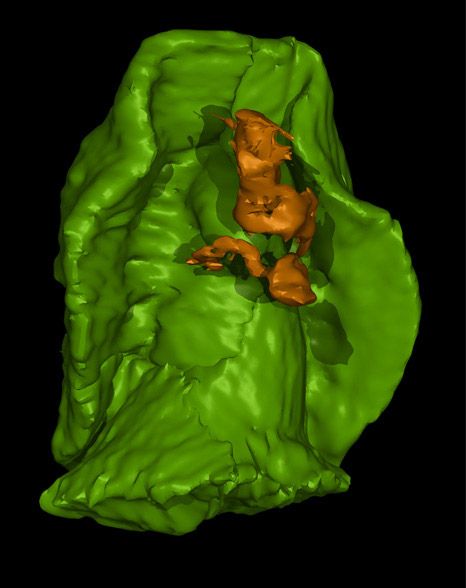It Was Alive! Ancient Blob Recreated in 3-D

A primordial living blob that once inhabited the ocean became entombed within volcanic ash for 425 million years, but researchers have now resurrected its soft body as a 3-D computer model.
The body of the cone-shaped animal, named Drakozoon kalumon, reached just 1.7 millimeters long, but also had leathery outer skin and a hood that reached 2.2 millimeters long. When threatened, it may have pulled down the hood over its body for protection against predators. [3-D image of blob]
The new 3-D recreation has given researchers fresh insight into the specimen discovered six years ago.
"We think this tiny blob of jelly survived by clinging onto rocks and hard-shelled creatures, making a living by plucking microscopic morsels out of seawater," said study researcher Mark Sutton, a paleobiologist at the Imperial College London in England.
Its two coiled arms likely did the work of feeding. "If it worked like a brachiopod, and I suspect it did, it would have used fine setae (hairs) on the arms to generate currents, catch tiny pieces of food in the seawater, and pass them down the arms into the waiting mouth," Sutton told LiveScience.
The preserved blob was attached to the fossilized shell of a type of spineless shellfish known as a brachiopod. Researchers made the discovery about six years ago in the Herefordshire Lagerstatte, one of England's richest deposits of soft-bodied fossils.
Close analysis of the 3D model has revealed eight deep ridges on either side of the blob's body. Such ridges may represent leftover features from an earlier time when the body of Drakozoon's ancestor consisted of repeated units – and that supports a theory that the earliest creatures on Earth also had bodies made of repeated units.
Sign up for the Live Science daily newsletter now
Get the world’s most fascinating discoveries delivered straight to your inbox.
Scientists still debate about whether the earliest creatures had repeated units similar to a caterpillar's many segments and legs, or whether they had more free-form bodies, such as those of slugs.
The new study also shows that the blob represented an early member of a major group of invertebrate species called lophophorates, which also includes the spineless brachiopods. The marine creatures lived together during the Silurian Period, from about 444 million to 416 million years ago.
Creating the 3-D computer model of the blob required a physical sacrifice. Researchers had to slice up the unique fossil specimen into 200 pieces, so that they could photograph each piece individually and feed the images into a computer for analysis.
Still, researchers may find the sacrifice of a rare soft-body fossil worthwhile in their quest to understand how the first relatives of all creatures on Earth evolved.
Though such soft-bodied creatures are absent from the fossil record elsewhere, the researchers suggest they may have been widespread long ago. "Small soft-bodied forms such as Drakozoon undoubtedly had a very low preservation potential," the researchers write in the most recent issue of the journal Biology Letters.
Very few places in the world preserve these blobs by various flukes of nature. "Very few of these preserve them in 3-D, or in as fine detail as the Herefordshire site," Sutton said.
- 25 Amazing Ancient Beasts
- Dangers in the Deep: 10 Scariest Sea Creatures
- Top 10 Useless Limbs (and Other Vestigial Organs)










